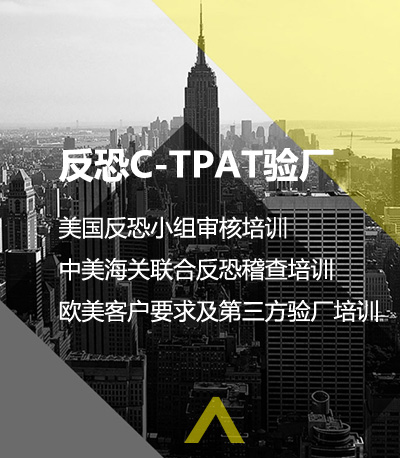ETI驗(yàn)廠Chuangsheng Csr
192016-3
ETI (sedex)認(rèn)證要求
信息來(lái)源:驗(yàn)廠之家 瀏覽次數(shù):1766次
What is social auditing?
Social auditing, or ethical auditing, as it’s also sometimes referred to, is a formal assessment of working conditions. It is usually carried out on behalf of a retailer or brand that wishes to measure a supplier company’s compliance with a standard such as the ETI Base Code.What does it involve?
Social auditing involves a systematic review of working conditions against a code, such as a company’s own code, the ETI Base Code, Sedex’s SMETA system – a widely used protocol based on the ETI Base Code – or Social Accountability International’s SA8000 Code.
What are factories assessed on? Are there criteria for them to pass?
There are over a thousand ethical codes in existence. Fortunately, most of them are very similar to each other and almost all of them, including the ETI Base Code, are based on the conventions of the International Labour Organisation. The SMETA system is one of the most widely used.
At ETI we do not use the language of ‘pass or fail’ in audits, as our approach to ethical trade is based on continual improvement. Instead, we believe that any audit should generate a report and a plan of corrective actions to fix whatever problems the audit uncovers.
What happens during an audit and what does it cover?
A thorough audit should include a physical inspection of the workplace, examination of records such as pay and working hours, meetings with workplace managers and, most importantly, private interviews with workers themselves. Trade unions or other legitimate representatives of workers should also be involved throughout the process.
Sedex’s SMETA audit system is typical and very widely used.
The ETI Workbook, which is now free to download, also provides guidance on how to plan and carry out inspections.
How often are the factories assessed? What would constitute too often?
There is no ‘one size fits all’ answer to this question. Most companies use a risk assessment process to decide whether suppliers need auditing, and how often. Although some companies audit all their suppliers, most only audit the ones that are rated high risk. For lower risk factories, they tend to rely on routine technical and commercial visits to assess ethical performance.
One of the limitations of audits is that even the best of them won’t pick up problems before they have happened. They will only find problems once they are occurring. So audits almost always do find issues, but that doesn’t mean they’re not being done frequently enough.
ETI’s one-day, one-site risk assessment tool helps companies to prioritise their auditing activities.
Are the factories aware when they are going to be audited?
Sometimes they are, sometimes not. The advantage of announced audits is that the auditors can arrange for all the people they need to see and all the relevant documents to be available. On the other hand, an unannounced audit gives auditors the opportunity to see the place unprepared.
In practice, however, it makes less difference than you might imagine. Most big workplaces supplying UK retailers get many visits from their customers. Some get audited many times a year and have many more commercial visits. This means that they don’t really put on a show for the visitors – it’s just like that all the time. On the other hand, at a big factory it can take half an hour to get through the security procedures and inside to the factory floor. This is plenty of time for a dishonest factory owner to hid things he or she would rather the customer didn’t see.
Most professional auditors are aware of all of these things and are generally very good at detecting attempts to put on a show or to deceive them.
What are some of the typical scenarios in factories?
There’s no hard and fast rule here. Some specific problems are more common in certain countries and industries. Low wages, excessive working hours, no security of employment and discrimination against women are all common everywhere. Slavery and forced labour are particularly common in south and east Asia – in fact, there are more slaves in the world now than there ever have been in the past. Child labour is less frequently found, but is likely to be more widespread than audit data suggest, particularly in agriculture and the informal sector.
Migrant workers and women are particularly vulnerable to exploitation, but audits are not always very good at picking this sort of thing up. In fact, the most commonly reported problems are to do with health and safety. The next most common are issues that relate to written records, such as pay and hours. The so-called ‘soft’ issues such as discrimination and harassment are less easy to spot and therefore less reported, but likely to be no less common. One of the most under-reported issues is employers preventing workers from joining a trade union.
Who conducts the audits and what skills do they require?
This varies greatly. Audits may be done by the supplying company, by the buying company or by an independent third party organisation. They might be done by a single auditor or by a team, possibly with a range of backgrounds. This last is known as a multi-stakeholder audit. Most social audits are carried out by independent professional auditors with experience in social auditing, preferably from the same ethnic community as the workers themselves. Auditors need to understand local language and culture in order to pick up some of the less obvious problems, such as gender discrimination and harassment. Since women workers in particular are reluctant to talk openly about such issues, it is likely to help if the auditor is a local woman.
The ETI Workbook contains guidance on what makes for an effective audit team.
What happens after the audit? If it was bad, what measures are taken?
After the audit, the auditor will usually agree the findings with the factory manager and get him or her to sign his/her acceptance. The report is then sent to the client who commissioned the audit; normally this is the buying company. Either the auditor or the client will then agree a corrective action plan with the factory, which must be completed within a defined time frame. Often there will be a follow-up audit to check that the corrective actions have been taken within the agreed timescales.
At the heart of our approach to ethical trade is our belief that when non-compliances are found, encouraging suppliers to make improvements is more responsible than abandoning them when serious issues are found.
Where serious breaches of a code are found, we recommend that companies require the supplier to undertake swift corrective action as a condition of their continuing to trade with them.
In rare situations, a supplier may be unwilling or unable to change, or have failed to make agreed improvements. In such cases, the only option left available may be to disengage from that supplier. Companies should have transparent criteria for disengagement.
How do the suppliers prove they’ve ‘passed’ the audit?
Again, this is not the language that ETI uses. An audit is an investigation, not a test. When problems are found, the company that was audited will be asked to demonstrate that any corrective actions have been completed within agreed timescales.
How are factories and companies encouraged to be ethical?
We call this process ‘capacity building’. First, the buying company must explain clearly to the factory what it wants. It needs to give them copies of the code, both in their own language and in the workers’ language. This might be different if there is a predominantly migrant workforce. It’s important to go through it with them and to spend time explaining why it wants them to make improvements, and how it will make their workplace better. This will often involve running training courses and perhaps helping the factory to improve its human resources systems.
It’s really important to encourage the factory to own up about the issues they face. Unless they are prepared to be honest, you can’t help to put things right.
What is the future of social auditing?
Companies rely heavily on auditing to know what’s going on in the factories and workplaces that supply the products they sell. This is unlikely to diminish much, but at ETI we strongly believe that much of their investment in auditing would be more effectively spent on prevention and training programmes. Audits are necessary, because they indicate that there’s a problem. However, they don’t fix the problem or necessarily prevent future ones.
How effective is social auditing?
This depends on many factors; for example:
· Is the audit method robust?
· Is the auditor well-trained and knowledgeable about issues in the industry being audited?
· Is he/she able to communicate effectively with workers?
· Is the company being audited open and honest?
· Was the factory operating normally on the day of the audit?
· Are the problems intermittent? Did they happen when the auditor was there?
· Were the right people for interviews selected? Did they feel able to tell their story in confidence?
Audits can tell us a lot, but a single, isolated audit rarely gives the whole picture. Audits are more effective when successive audit reports can be looked at together to build up a clearer understanding over a period.
How are some audit companies trying to make audits more effective?
Many audit companies recognise that the old ‘comply or die’ approach to social auditing simply doesn’t work, and are trying to improve their investigation methods and also the competency of individual auditors. They are trying to get better at uncovering the root causes of problems, rather than just the symptoms.
What are the costs involved? Would a cheaper audit affect the reliability?
Audit costs vary a lot, depending on where the supplier company is located, how many auditors are required and how long the audit will take. Typically they cost from £350 to £1000, but a detailed ‘forensic’ ethical audit may be much more expensive.
How long does an audit take?
This depends on the size of the company being audited, how many workers they have, how many shifts they operate, how complex the production process is, and so on. In small companies it is possible to conduct an assessment in a day, but full audits often take longer than this, especially if lots of workers are interviewed.
Why do companies do ethical audits? Do they gain anything?
Companies use ethical audits to discover whether working conditions in their supply chains are satisfactory. They can help them identify where the issues are for workers and also help them track progress in improving conditions over time.
How do you measure the effectiveness of ethical auditing?
One way this can be done is to carry out ‘shadowed’ audits. A shadowed audit is when two auditors work together, one observing the other. This allows them to find out if agree about what they find. Usually it might be someone from the buying company or maybe from a local NGO or trade union who shadows the professional auditor.
Another way is to compare audit findings at one site over time, or against other similar workplaces. Ironically, the better the audit, the more likely it will be to pick up non-compliances, and so analysing trends over time is often a challenge. A superficial look at a series of audit reports may indicate that conditions in a given supplier’s factory are getting worse – however it may simply be because the quality of the audit is improving.
How do ethical audits affect trading?
ETI encourages companies to award more trade to suppliers who trade ethically and to take business away if suppliers consistently fail to protect their workers’ rights.
Do companies pay attention to the results of ethical auditing?
Buying companies generally do - they’d be wasting money if they didn’t take the results of audits seriously and act on them to improve things. And as long as suppliers know that their buyers will follow up on audits, they also generally pay attention. Often they need help to work out how to act on the audit findings in the most effective way.
What effect does an audit have on a factory?
A good audit report can enhance the reputation of the factory in the eyes of the buyer and may give the buyer confidence to place more orders with the factory. A poor result may have the opposite effect, particularly if the factory doesn’t do enough to fix the problems found.
How does the auditing company avoid corruption among its staff?
Auditor fraud isn’t common, but it does happen, and when it does, it is difficult to deal with. In some cultures bribery is very commonplace and is more likely to happen if an auditor is working on his own. The result of the audit should always be checked as part of the audit company’s own quality control procedures. If the auditor hasn’t reported much at a particular site, this could indicate that he or she could be missing things, or else might be corrupt.
What improvements should be made to social auditing and why?
Thorough, informative audits are a really useful thing to help companies understand the way their products are made. Unreliable, inaccurate audits are useless, costly and misleading.
The best audit companies regularly monitor their own performance and find ways to improve the effectiveness of their audit process. Things that can be done include better training of auditors, better selection of auditors appropriate for particular factories, more time spent talking to workers and questions aimed at uncovering root causes of problems, not just the obvious symptoms.
Copyright © 2024 huangjingwu.cn 東莞市創(chuàng)盛企業(yè)形象策劃有限公司
地址:廣東省東莞市南城區(qū)鴻禧中心A區(qū)608室 電話: 0769-22324329/22362295 粵ICP備11014164號(hào)
地址:廣東省東莞市南城區(qū)鴻禧中心A區(qū)608室 電話: 0769-22324329/22362295 粵ICP備11014164號(hào)








